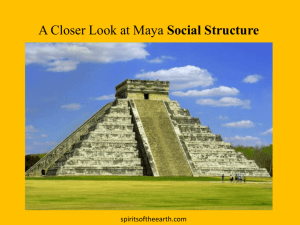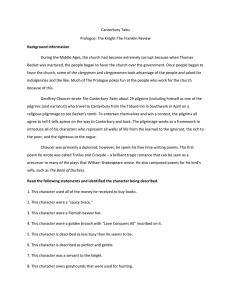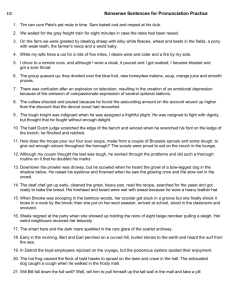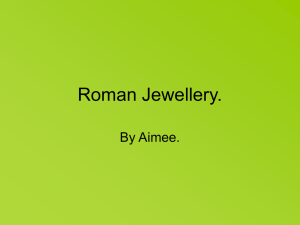Brown Ashly SS4H1 Gace study guide and quilt square
advertisement
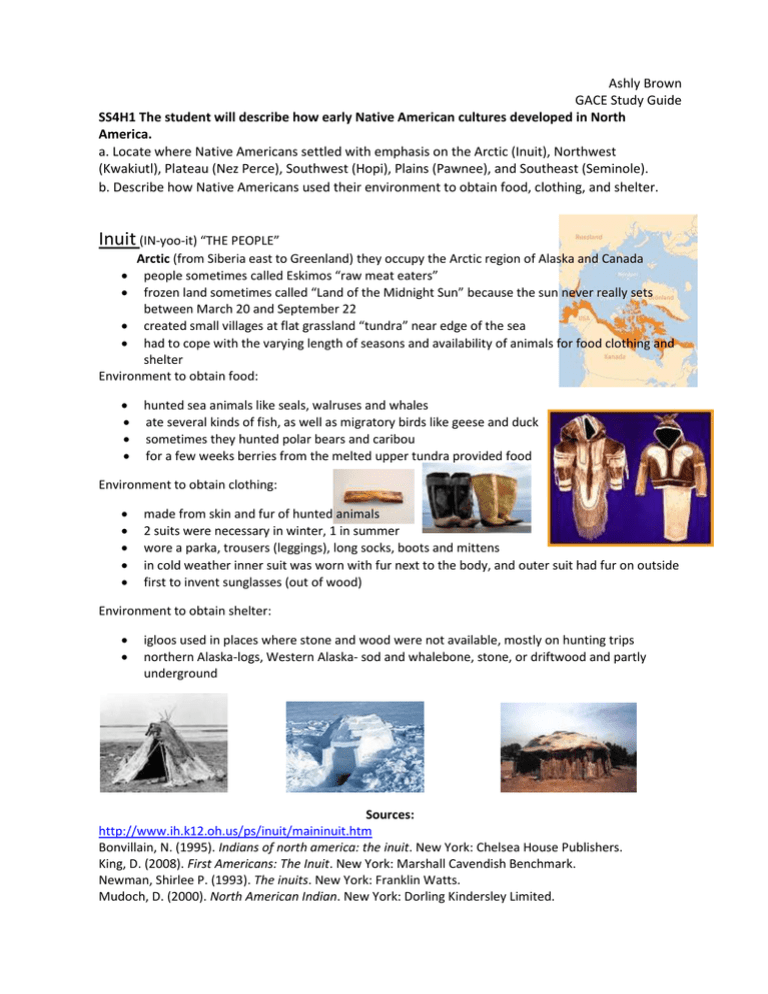
Ashly Brown GACE Study Guide SS4H1 The student will describe how early Native American cultures developed in North America. a. Locate where Native Americans settled with emphasis on the Arctic (Inuit), Northwest (Kwakiutl), Plateau (Nez Perce), Southwest (Hopi), Plains (Pawnee), and Southeast (Seminole). b. Describe how Native Americans used their environment to obtain food, clothing, and shelter. Inuit (IN-yoo-it) “THE PEOPLE” Arctic (from Siberia east to Greenland) they occupy the Arctic region of Alaska and Canada people sometimes called Eskimos “raw meat eaters” frozen land sometimes called “Land of the Midnight Sun” because the sun never really sets between March 20 and September 22 created small villages at flat grassland “tundra” near edge of the sea had to cope with the varying length of seasons and availability of animals for food clothing and shelter Environment to obtain food: hunted sea animals like seals, walruses and whales ate several kinds of fish, as well as migratory birds like geese and duck sometimes they hunted polar bears and caribou for a few weeks berries from the melted upper tundra provided food Environment to obtain clothing: made from skin and fur of hunted animals 2 suits were necessary in winter, 1 in summer wore a parka, trousers (leggings), long socks, boots and mittens in cold weather inner suit was worn with fur next to the body, and outer suit had fur on outside first to invent sunglasses (out of wood) Environment to obtain shelter: igloos used in places where stone and wood were not available, mostly on hunting trips northern Alaska-logs, Western Alaska- sod and whalebone, stone, or driftwood and partly underground Sources: http://www.ih.k12.oh.us/ps/inuit/maininuit.htm Bonvillain, N. (1995). Indians of north america: the inuit. New York: Chelsea House Publishers. King, D. (2008). First Americans: The Inuit. New York: Marshall Cavendish Benchmark. Newman, Shirlee P. (1993). The inuits. New York: Franklin Watts. Mudoch, D. (2000). North American Indian. New York: Dorling Kindersley Limited. Kwakiutl (Kwah-kee-oo-tel, or Kwah-kee-olth) “Kwakwaka'wakw” Northwest (original people of the Pacific Northwest Coast, they live in British Columbia, Canada) Environment to obtain food area great for fishing, since they had deep, cold, murky waters variety and abundance of fish such as eulachon, herring, smelt, cod, rockfish, lingcod, halibut, eel, sturgeon, and dogfish five species of Pacific salmon (staple food) other sea foods like mammals-porposes, seals, sea lions, sea otters, whales, sea birds and other sea fowl mullosks- clams, muscles, oysters, limpets, aldone, crabs, octobus, squid and sea urchins eggs from sea gulls and puffins hunted black bears, grizzly bears, and wolves Environment to obtain clothing mats for floors were also used as clothing during cold, wet, weather, warm and water resistant clothing was mandatory most common of the dress was a garment like a cedar bark cape or cloak, or blanket cedar bark was sometimes woven together with wool of a mountain goat the tribe raised wooly dogs for the purpose of the thick coat (clothing was rubbed in fish oil, to increase water resistance) wore few clothes in summer (males wore breechcloth or nothing at all, women wore a short skirt only) during special occasions, they would wear fancy moccasins for ceremonial dress but, most of the time, they went barefoot Environment to obtain shelter summer villages were built near prime fishing spots; composed of small, rectangular wooden cabins with long, sloping or flat roof for temporary use winter villages were built in sheltered locations that offered protection from high winter tides and fierce storms from the Pacific Ocean winter villages consisted of large houses, sometimes elevated on stilts to escape tides with doorways facing beach or ocean in steep areas, platforms were built to support the homes, boardwalks were laid around the entire village, in front of houses. Sources: http://www.angelfire.com/hi4/Magik8Ball/Kwak.html http://www.bigorrin.org/kwakiutl_kids.htm Nez Perce (nɛzˈpɜrs) “Nimapu-the Real People” Northwest (covered parts of Washington, Oregon, Montana, and Idaho, in an area surrounding the Snake, Salmon and the Clearwater rivers) the tribal area extended from the Bitterroots in the east to the Blue Mountains in the west between latitude 45°N and 47°N Environment to obtain food hunters and root-gatherers mainly fish-eating people depending mostly on salmon camas bulb, bitterroot, wild carrot, wild potato, and other root crops fruit collected included service berries, gooseberries, hawthorn berries, thorn berries, huckleberries, currants, elderberries, chokecherries, blackberries, raspberries, and wild strawberries other food gathered includes pine nuts, sunflower seeds, and black moss large game animals- deer, elk, moose, bear (black, brown, and grizzly), mountain sheep and goats small game- rabbit, squirrel, badgers, and marmot/ birds such as ducks, geese, ruffed grouse, and sage hens buffalo meat was added to their diet when they began trading with Plains Indians Environment to obtain clothing men wore long, fringed buckskin shirts, leggings, belts, a breech cloth, and several types of moccasins and occasionally gloves in the cold weather, men wore bison skin robes women wore long, belted buckskin dresses, corn husk basketry hats, and knee length moccasins the dresses were decorated with elk teeth, beads made of shell, bone, and later glass, porcupine quills, and vegetable and mineral dyes feathered bonnets were also a common trait Environment to obtain shelter lived in groups of extended families, in small villages along streams and rivers principal house was the Tule mat-covered long house with varying lengths that could reach over 100 feet long at times, semi subterranean dormitories were used in conjunction with the long house to accommodate single men and women house pits or excavated dwellings were also used by families simultaneously with the matcovered long house structures house pit structures became less popular after the introduction of the tipi, made using twelve wood poles with Tule mat covers which were eventually replaced by bison skins a circular semi subterranean Plateau sweat house, women's menstrual huts, and the submerged hot bath were also part of the settlements Sources: http://www.nezperce.org/history/frequentlyaskedq.htm#who Mudoch, D. (2000). North American Indian. New York: Dorling Kindersley Limited. Osinski, A. (1988) “The Nez Perce.” Chicago: Children’s Press. Trafzer, C. (1992) “Indians of North America: The Nez Perce.” New York: Chelsea House Publishers. Hopi (hō-pee)“good in every aspect or good, peaceable, wise and knowing” Southwest (Southwest region of the United States, concentrated in northern Arizona) Environment to obtain food way of life dependent on farming but very little water and rainfall several types of corn (white, blue, and sweet), plants, numerous varieties of beans and squash hunted for small animals such as rabbits and desert rodents occasionally traveled farther into the mountains to hunt antelope and deer piki bread made out of blue cornmeal was their most prized food Environment to obtain clothing made use of many varieties of plants growing naturally in the environment men wore woven cotton shirts and aprons over deerskin leggings women wore woven blouses and skirts clothing was sometimes brightly embroidered with contrasting colors and designs both men and women adorned themselves with sashes, necklaces, and turquoise jewelry Environment to obtain shelter all villages built on same plan consisting of clay and stone houses that are placed next to each other along rows forming streets each village contains at least one large open courtyard or plaza where people gather Sources: Bonvillain, N. (1994) “Indians of North America: The HOPI.” New York: Chelsea House Publishers. Mudoch, D. (2000). North American Indian. New York: Dorling Kindersley Limited. Pawnee (Paw-nee, also Paneassa, Pari, Parik) “horn” Plains (historically lived along outlying tributaries of the Missouri River: the Platte, Loup and Republican Rivers in present-day Nebraska and in Northern Kansas.) Environment to obtain food farming people women raised crops of corn, beans, squash, and sunflowers men worked to herd buffalo and antelopes originally they herded buffalo to marshy land where it was easier to shoot but after Europeans arrived they hunted them on horseback Environment to obtain clothing women wore deerskin skirts and poncho-like blouses men wore breechcloths and leather leggings men did not normally wear shirts but warriors sometimes wore buckskin war shirts wore moccasins on feet and long buffalo-hide robes in cold weather lady’s dress or warrior’s shirt was fringed and often decorated with beadwork and painted designs Environment to obtain shelter most lived in settled villages of round earthen lodges lodges were made from wooden frames covered with packed earth they used buffalo-hide teepees as a temporary shelter on hunting trips Sources: http://www.bigorrin.org/pawnee_kids.htm http://www.accessgenealogy.com/native/tribes/pawnee/pawneehist.htm Seminole “runaway or wild people” Southeast (northern and central Florida) some lived in Georgia and were known as Creek Indians before European explorers pushed them out Environment to obtain food herders of cattle and farmed corn, squash, and beans became gatherers once they were no longer able to raise cattle hunters of fish, turtle, deer, turkey, bear, otter, raccoon, squirrel, rabbit, alligators and fresh and salt water fish main crop was corn (also made special drink from corn called Sofkee) ate pumpkin Environment to obtain clothing wore clothing made out of leather women wore long apron-like skirts and puffy blouses (also wore beaded necklaces) wove cloth from inner fibers of mulberry tree men typically wore loin cloth and leggings they were fierce warriors that painted and tattooed their bodies (also wore feathers in hair) Environment to obtain shelter lived in swampy Everglades so they formed villages on hammocks (islands of thick forests) most lived in a chickee (open house made out of cypress trees with a palmetto-leaf roof and a floor raised above the ground) built sweathouses near rivers for purification Sources: Garbarino, M. (1989) “Indians of North America: The Seminole.” New York: Chelsea House Publishers. Lund, B. (1997) “The Seminole Indians.” Mankato: Bridgestone Books. Mudoch, D. (2000). North American Indian. New York: Dorling Kindersley Limited.

